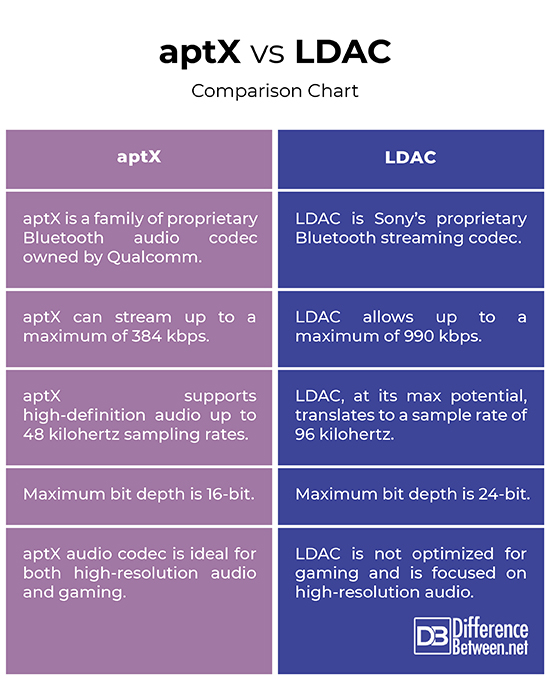Difference Between aptX and LDAC
The Bluetooth wireless standard has revolutionized the way we listen to music. The traditional cable set-ups are found in either extremely high-quality hi-fi audio or on cheap headsets that come with smartphones. Technically, Bluetooth uses a combination of circuit and packet switching technology to handle voice and data traffic. While Bluetooth Special Interest Group (BSIG) is responsible for defining the protocol’s specifications, there are other players out there, mainly companies, who are developing new ways to encode and decode their wireless data stream. We take a look at two of the most important Bluetooth codecs and their difference between them.

What is aptX?
The aptX is an audio codec meant for premium audio quality and low-latency. It is basically a family of proprietary Bluetooth audio codec owned by Qualcomm. It is a technology that compresses and decompresses audio as it travels from a source device like your phone or laptop to a receiving device like a Bluetooth speaker or a headphone, without hampering the audio quality. With aptX, you have the convenience of Bluetooth without compromising the sound quality. The aptX audio codec provides high definition voice quality over a connection using Bluetooth wireless technology.
The aptX Adaptive audio technology is designed to significantly enhance the quality of voice for those who use Bluetooth accessories to make voice calls. Today, aptX is the technology behind leading Bluetooth headphones, speakers, and smartphones. However, in order to achieve the full potential of aptX, it has to be on both the source devices and the receiving devices. It delivers a CD like audio quality, making sure you have an uncompromised and uninterrupted audio experience.

What is LDAC?
LDAC is Sony’s proprietary Bluetooth streaming codec that allows you to enjoy high quality wireless audio over a Bluetooth connection. LDAC uses the Bluetooth’s optional Enhanced Data Rate (EDR) technology to increase data speeds outside of the usual A2DP profile limits. It allows you to send bigger files than you’d normally be able to send at higher level of quality. It allows up to a maximum of 990 kbps with a sampling depth of 16-bit at 48 kilohertz. It’s still not clear what the acronym actually stands for since Sony has never defined it.
It provides a high quality listening experience for all your music. LDAC is very different from other Bluetooth audio codecs in that it uses a combination of lossless and lossy compression to deliver uncompromising audio. The closest competitor to LDAC is Qualcomm’s aptX HD, which supports 24-bit, 48 kilohertz audio data. LDAC was developed by Sony, so you’ll mostly find LDAC codec support in Sony products. It can be found in Sony headphones such as the Sony WF-1000XM4 and the Sony WH-1000XM4.
Difference between aptX and LDAC
Streaming
– Both are popular Bluetooth streaming audio codecs that allow for high quality audio experience. aptX can stream up to a maximum of 384 kbps with a sampling depth of 16-bit at 48 kilohertz; aptX HD can stream up to 24-bit at 48 kilohertz up to a maximum of 576 kbps bit rate. LDAC allows up to a maximum of 990 kbps with a sampling depth of 16-bit at 48 kilohertz. Smartphones rarely pick the 990 kbps option when connecting to LDAC devices.
Latency
– The audio latency between aptX and LDAC doesn’t differ much. The latency of the aptX is approximately 40ms which delivers sound in sync with what plays on the screen, so you can never miss a beat. The latency of the aptX HD audio codec can be scaled to as low as 1ms for 48 kilohertz, depending on the settings of other configurable parameters. aptX LL is the only codec that allows <50ms end-to-end latency. LDAC is solely focused on high-resolution audio and is not optimized for gaming.
aptX vs. LDAC: Comparison Chart

Summary
One downside of LDAC audio codec is that when it drops to its lowest 330 kbps bit rate, it performs worse than the original aptX Bluetooth codec. That being said, the original aptX can stream up to a maximum of 384 kbps with a sampling depth of 16-bit at 48 kilohertz, whereas the LDAC supports a maximum of 990 kbps with a sampling depth of 16-bit at 48 kilohertz. However, LDAC is solely focused on high-resolution audio and is not optimized for gaming, thanks to its high latency. The world of wireless audio is as confusing as it is fascinating, especially when talking about codecs. The key to a supreme audio experience is to know what audio codecs are supported on your devices.
Is aptX better than LDAC?
According to Sony, LDAC audio codec allows roughly three times more data to be streamed over Bluetooth. However, LDAC, because of its high latency, is not optimized for gaming. Besides, LDAC supports a maximum of 990 kbps bit rate whereas aptX supports up to 384 kbps.
What is LDAC and aptX?
LDAC is a relatively new codec available on select Sony headphones; LDAC is Sony’s proprietary Bluetooth streaming codec. aptX is a similar audio technology but developed by Qualcomm. Both are two of the most important Bluetooth codecs in the world of wireless audio.
Is LDAC lossless Bluetooth?
LDAC allows streaming of high-resolution audio over Bluetooth at up to 990 kbps. At its maximum potential, it’s probably the highest quality codec. With three times the data transmitted, LDAC provides an uncompromising wireless listening experience.
Which audio codec is best?
AAC is currently the best audio codec for most situations and it is supported by a wide range of devices and software platforms.
- Difference Between Caucus and Primary - June 18, 2024
- Difference Between PPO and POS - May 30, 2024
- Difference Between RFID and NFC - May 28, 2024
Search DifferenceBetween.net :
Leave a Response
References :
[0]Bouhaï, Nasreddine and Imad Saleh. Internet of Things: Evolutions and Innovations. New Jersey, United States: John Wiley & Sons, 2017. Print
[1]Verdult, Vincent. Optimal Audio and Video Reproduction at Home: Improving the Listening and Viewing Experience. New York, United States: Routledge, 2019. Print
